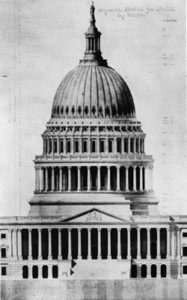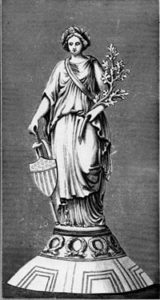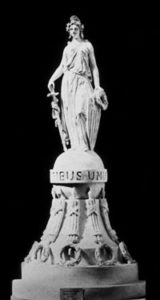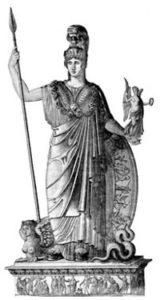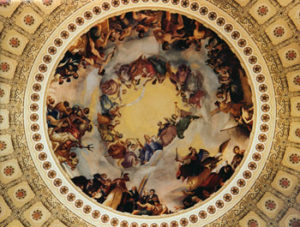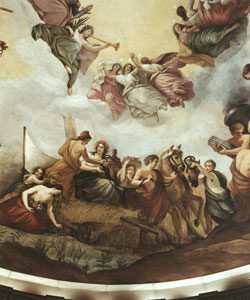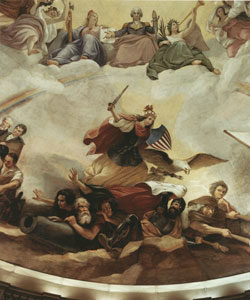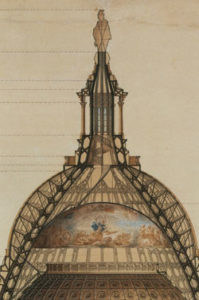During Barack Obama’s swearing-in ceremony as the 44th president of the United States, the first African American to be elected to this office proclaimed: “the time has come to reaffirm our enduring spirit; to choose our better history; to carry forward that precious gift, that noble idea, passed on from generation to generation: the God-given promise that all are equal, all are free, and all deserve a chance to pursue their full measure of happiness.” As he said these words, President Obama stood in front of the U.S. Capitol Building and beneath its colossal bronze dome statue: Thomas Crawford’s Statue of Freedom (fig. 1). This historic scene becomes all the more significant when we consider the history and meanings of the Statue of Freedom, one of the most visible icons in Washington, D.C.
Now assumed to be a symbol of national unity or an Indian Princess, Crawford’s statue emerged out of the contest between the North and South. Between 1853 and 1857, Jefferson Davis used his position as the Secretary of War in charge of the construction and decoration of the Capitol extension to eliminate references to slavery in a public building that belonged to both regions. This slave owner, congressman, and senator from Mississippi who later became president of the Confederacy vehemently argued for the slave system and the extension of slavery into newly acquired lands. He also used his cabinet position to occlude references to slavery by accepting, rejecting, and recommending changes in the iconography of particular artworks. Crawford’s intentions in the statue’s iconography were co-opted by Davis, whose programming for the statue’s meaning influenced the artist from the beginning. In fact, the Statue of Freedom, begun in 1855 after the highly controversial passage of the Fugitive Slave Act (1850) and the publication of Harriet Beecher Stowe’s Uncle Tom’s Cabin (1851) and finished in 1863 during the Civil War, has as much to teach us about the intricacies of race and racism as it can about the politics of public art and slavery. Only after we know the statue’s history and examine it in the context of antebellum literature and art can we truly understand it. By considering the statue alongside Herman Melville’s novella, “Benito Cereno” (1855), Constantino Brumidi’s dome fresco in the U.S. Capitol Rotunda, and Thomas Nast’s response to the Emancipation Proclamation in Harper’s Weekly, we can recover Crawford’s statue as an articulation and visualization of the politics of race, racism, and slavery within the public imagination and political realm of Washington, D.C.
In addressing these complexities, I employ the “veil of race” metaphor constructed by W. E. B. DuBois throughout his 1903 book, The Souls of Black Folk, in which bondage and freedom are intertwined in the same way they are in Crawford’s Statue of Freedom, Melville’s narrative about a fictional slave revolt, Nast’s visual celebration of the Emancipation, and Brumidi’s dome fresco. DuBois, a civil rights activist, historian, and founder and editor of The Crisis, the journal for the National Association for the Advancement of Colored People (NAACP), used the “veil of race” metaphor in Souls of Black Folk to claim that whites fail to see blacks, who are “shut out from their world by a vast veil.” This invisibility had profound consequences for African Americans: “The awful shadow of the Veil … hung between us and Opportunity,” he argued, asserting that “the problem of the twentieth century is the color-line,” which contributed to “the Negro problem.” For DuBois, real freedom, as opposed to emancipation, would only occur once this veil was lifted. DuBois’s metaphor and Melville’s novella can help us understand how the contradictions embodied in the Statue of Freedom did—and did not—work to veil slavery. What will become evident is that the veil over slavery was consciously and carefully created and protected, as well as challenged, in the nineteenth century.
Between 1853 and 1857, Jefferson Davis used his position as the Secretary of War in charge of the construction and decoration of the Capitol Extension to eliminate references to slavery in a public building that belonged to both regions.
To understand Davis’s role in attempting to remove visual symbols of slavery from the U.S. Capitol building’s decoration, it is necessary to revisit the complex iconography of Crawford’s Statue of Freedom, which I had earlier discussed in Art and Empire. There I show that Thomas U. Walter, the architect of the U.S. Capitol, had first suggested in a preliminary drawing of 1855 (fig. 2) that a monumental statue crown the new dome of the Capitol extension. In creating an allegorical female figure holding a pole surmounted by a liberty cap, Walter appropriated the well-known iconography of Libertas.
Libertas traditionally appears in the visual arts as a female who wears a Phrygian cap (also referred to as a pileus) and who holds a staff or stake, the so-called “liberty pole.” In Latin, the word libertas means freedom, the state of being free from physical constraint or despotic control. The personification of liberty thus derives from antiquity, where it first stood for personal freedom from manumission and, later, in the Roman empire, when it referred to both political liberty and constitutional government. The personification became codified in seventeenth-century emblem books and was used subsequently during the American and French Revolutions. During that time, Libertas symbolized freedom from tyranny, as is evident in the Paul Revere masthead for the Massachusetts Spy in 1781 (fig. 3). But the liberty cap and staff that Augustin Dupré depicted on the coin Libertas Americana in 1781 (fig. 4) disappeared from the first U.S. pattern dime of 1792 because some considered the symbols of ancient Roman manumission too inflammatory for inclusion on U.S. coins. By the 1850s when Walter first suggested this allegory for the Capitol dome, Libertas already was well known throughout U.S. art and culture and held references to freedom and slavery, references that threatened the tenuous link between North and South.
Although Crawford had been commissioned to realize Walter’s plan, his first design (fig. 5) inexplicably departs from the architect’s initial proposal and the tradition for Libertas. His Freedom Triumphant in War and Peace fails to include any of the well-known symbols of cap or liberty pole. Instead, Crawford rendered a female figure with two symbols associated with war and peace—the sword and olive branch—creating a vague preliminary design that lacks clarity of meaning and composition.
Four months later, Crawford submitted a revised design in which he abandoned the theme of peace and established more clearly the work’s reference to Libertas. In this second version for Statue of Freedom, Crawford followed Walter’s concept of depicting a female figure in long robes and the Phrygian cap (fig. 6). Crawford added four other emblems: the shield of the United States, “the triumph of which,” Crawford maintained, “is made apparent by the wreath held in the same hand which grasps the shield”; a sword held in her right hand, “ready to use whenever required”; a globe upon which Liberty stands and which represents “her protection of the American world”; and wreaths on the globe, which, according to the artist, signify unity and justice. Crawford finished the statue by placing stars upon her crown “to indicate her Heavenly origin.” This second design, which both Crawford and Davis referred to as “armed Liberty,” eliminated the olive branch and its reference to peace, and retained the sword.
The militarism suggested by the sword is reiterated by the addition of the globe. Crawford’s “American world” corresponded to the vision of the United States as a great empire that would influence other nations to adopt its republican form of government. The orb also suggests the nation’s expanded view of manifest destiny, which extended beyond the continent to encompass Cuba and the Caribbean. “Armed Liberty” thus reflects the militaristic rhetoric of the 1850s and matches the administrative responsibilities of Jefferson Davis, who as the Secretary of War advocated the purchase of Cuba and Nicaragua as a means to expand slavery farther south into other nations. And the second version significantly returned the liberty cap to the allegory’s head.
Although the statue adhered to his ideological agenda as Secretary of War, Davis was troubled by the liberty cap. He argued in a letter to Montgomery C. Meigs, the supervising engineer of the Capitol extension, that the cap’s “history renders it inappropriate to a people who were born free and would not be enslaved.” He recommended that “armed Liberty” instead “wear a helmet,” given “that her conflict [is] over, her cause triumphant.” Davis, who would become the president of the Confederacy during the Civil War, understood ancient Roman slavery. It fell to Meigs to explain the situation to Crawford: “Mr. Davis says that he does not like the cap of Liberty introduced into the composition [because] American Liberty is original & not the liberty of the free slave.” Meigs explained that according to Davis, the cap that became a revolutionary symbol in France derived from “the Roman custom of liberating slaves thence called freedmen & allowed to wear this cap.”
Davis clearly understood the practice in ancient Roman manumission in which freed slaves covered their newly shorn heads with the pileus cap while magistrates touched them with a rod (the vindicta). He also understood that the liberty cap, which had referred to tyranny and freedom during eighteenth-century French and American revolutions, had come to signify antislavery causes by the middle of the following century. By refusing to garb an allegory of Liberty in a pileus cap, Davis rejected the notion that the slaves on his plantation also desired the same type of freedom, deliberately ignoring the perspective of the disenfranchised black slaves working in his cotton fields. In fact, Davis refused to allow any work in the U.S. Capitol Building to allude to slavery either overtly or covertly, via the cap or any other signification. Such maneuvers aimed to elide the tensions between the North and the South over this volatile issue during a period of escalating regional and political conflict. And although Crawford, like Walter in his initial design for the U.S. Capitol dome, may have intended the cap to refer to independence or the concept of liberty embodied in U.S. democracy, Davis’s objections ironically ensured that the symbol would be associated with Southern slavery regardless of the artist’s and architect’s original intent.
In response to Davis’s objections and recommendations, Crawford replaced the objectionable cap with a helmet and eagle feathers, transforming what clearly had been an allegory of Liberty into a hybrid monument that combines three traditional personifications: Liberty (signified by the title), Athena, the ancient Greek goddess, called Minerva in ancient Rome (signified by the helmet), and America (signified by eagle feathers). By adding the feathers to the helmet, Crawford associated America with Liberty, an iconographic tradition that began before the Revolutionary War, as in Paul Revere’s masthead (fig. 3), where the Indian princess with tobacco leaf skirt and headdress holds the cap and staff. A majestic and robust female figure, the Statue of Freedom especially evokes Athena/Minerva, goddess of war and of the city, protector of civilized life, and embodiment of wisdom and reason. Crawford’s figure, in fact, emulates Phidias’s fabled Athena Parthenos, a work reconstructed by Quatremère de Quincy in Restitution de la Minerve en or et ivoire, de Phidias, au Parthénon (fig. 7), which Crawford must have consulted. Both the ancient and the modern works include the helmet, the breast medallion, and the shield along the side. Even the fluted cloak gathered from the lower right to the upper left shoulder corresponds in these two matron types. Their immobility, severity of facial expression, military accoutrements, and colossal size convey rectitude and control.
Ironically, Statue of Freedom, meant to signify white superiority by Jefferson Davis, was assembled out of the discrete symbols of a host of Others: the black body (as embodied by the pileus and pole, which Davis insisted be omitted), the Indian body in the form of the eagle feathers and allegory of America as an Indian princess, the female body in the form of the female personification, and the “primitive” body, which intersects the first two. These Others were present within the nation writ large but excluded from full participation in its political and civic life.
Around the same time that Crawford was working through various designs for his Statue of Freedom, Herman Melville was at work on “Benito Cereno,“ a story based on actual slave revolts, which was first serialized in Putnam’s Monthly (1855) and then included in his collection of short stories, Piazza Tales (1856). Like Crawford’s statue, Melville’s novella speaks to the volatility of race and slavery in the antebellum United States. But unlike Crawford and his patron, Jefferson Davis, Melville aimed to pull aside and expose the multiple veils that white Americans used to conceal the realities of slavery and the threat of slave insurrection.
Melville opens the story with a description of a strange vessel (the San Dominick) that the captain of a Massachusetts whale boat sees slowly emerging from the fog off the coast of Chile. The weather thwarts Captain Delano’s effort to discern the people who occupy this vessel in distress. He initially mistakes the African slaves who occupy the ship for monks with “dark cowls,” perceiving the “dark moving figures” revealed through the open portholes as “Black Friars pacing the cloisters.” It takes a while for the captain to recognize that the San Dominick is a slave ship, carrying human cargo from one colonial port to another. Delano boards the slave ship to assist in its piloting. There he finds the exhausted Spanish captain, Benito Cereno, in a frenzied state, presumably as a result of a difficult journey around Cape Horn. Cereno appears to be under the nurturing care of his solicitous slave, Babo.
But on the San Dominick, appearances are deceiving. In reality, Babo is a liberty-seeking insurrectionist who has led a successful mutiny and gained control of the ship. Cereno is no longer a captain; instead he is Babo’s hostage. Delano and the reader continuously misread the situation, confusing slave and master.
The mutinous Babo especially acts the role of affectionate, imitative, docile, devoted, and “Sambo”-like servant, creating a cover that conceals his conspiracy of rebellion and murder. Babo’s masquerade—which the San Dominick’s captain understands completely and in which he participates against his will—remains a mystery to Delano until the end. The veil that has hidden mutiny and murder from Delano—and the reader—is removed literally and figuratively when the reality of mutiny and the murder of whites aboard the ship becomes known, slowly and dramatically. This occurs through the unveiling of the skeleton of the former ship’s owner, Don Alexandro Aranda, which Babo has used to replace the boat’s figurehead. Delano finally realizes Babo’s mutiny and beheads him. The masquerade performed by Babo and Cereno to mislead Delano tests both the American captain’s posture of innocence and that of Melville’s audience, exposing the captain’s own racial prejudices and revealing one way in which a white racist mind might react to slave insurrection.
Both Jefferson Davis and the fictional Babo deflect attention away from insurrection, although for opposite reasons: Davis wanted to forestall it and Babo to guarantee its success. Crawford’s statue and “Benito Cereno” thus expose the ironic relationship between liberty and slavery, which depends upon a series of veils, both literal and metaphoric. Just as Delano and the reader could not initially unmask the reality of slave revolt on the San Dominick, the Statue of Freedom, standing triumphantly over the globe of the world, successfully, if temporarily, masks the controversy over slavery and race behind the veil of Athena/Minerva or the Indian Princess. The liberty cap that Davis insisted be removed, in other words, continues to exist on some level because we can recover its presence (and erasure) through Davis’s and Meigs’s letters. The future president of the Confederacy believed that he could succeed, like Babo, in a masquerade that would pull a veil over the true meaning of the statue and its attendant associations with slavery. Whereas Babo’s plot becomes apparent to the reader and to Delano by the end of the narrative, Davis’s pro-slavery impulses succeeded for a time to veil the true meaning of the statue both as a symbol of freedom and as a reference to Southern slavery. In other words, whereas the skeleton of the murdered slave-trader is uncovered from the figurehead in “Benito Cereno” to expose the slave revolt and masquerade, the helmet never comes off the Statue of Freedom to reveal the “hidden” liberty cap. Melville’s story ends with Babo’s death; burnt to ashes, his head “for many days … fixed on a pole in the Plaza, met, unabashed, the gaze of the whites,” he faces a church in which the bones of Aranda were preserved. The skull of the black insurrectionist on the pole, in fact, emulates the cap on the staff that Walter had proposed in his initial design for the U.S. Capitol dome and that Davis insisted be banished.
“Benito Cereno,” like Crawford’s statue, also contributed to the debate over the extension of slavery in the 1850s, using the theme of black uprising to draw attention to the inhumanity of chattel bondage. Melville demonstrated in his short story that the history of U.S. resistance to slavery was a history of superimposed moments in which the destiny of the new republic—what some considered its providential design—was still very much at issue. Melville understood the scope and intricacy of contending pro- and anti-slavery forces, both of which were entangled in the ethos of revolution that defined the United States from the beginning and that was still implicated in slavery. The writer saw the centrality of slavery and slave revolt in antebellum U.S. political and cultural life and the corresponding shadow of blackness that the San Domingo’s successful slave revolt cast over the failed design for a democratic society. Davis, on the other hand, did everything possible to veil the reality of slavery on his plantation and signified by the Statue of Freedom, eventually leading the Confederacy in Civil War in his attempt to perpetuate that particular institution in the South.
The celebrated cartoonist Thomas Nast, and the Italian fresco artist who worked on the U.S. Capitol, Constantino Brumidi, commented directly on both the veiling at work in Crawford’s statue and the politics of that veiling. On the eve of the Civil War and during the war itself, these two artists used very different media to represent and reinterpret Crawford’s rendition of Libertas, lifting the veil that Crawford and Davis had placed in front of it so that its meanings could be more clearly discerned by U.S. audiences.
Published in Harper’s Weekly on January 24, 1863, just after a different revolution was brought about through Lincoln’s Emancipation Proclamation, Nast’s “The Emancipation of the Negroes, January, 1863—The Past and the Future” (fig. 8) positions Crawford’s proud and triumphant statue center stage, indicating that Liberty was explicitly suggested in the statue’s title and making it possible for some viewers to link an image of U.S. freedom with black emancipation. Within the engraving’s central frame, an African American family, united at last, participates in domestic activities under the watchful eyes of Lincoln, whose portrait is located by the fireplace. The forced separation of enslaved families gives special significance to the presence of the mother, father, sons, and daughters gathered around the hearth: Lincoln’s act has enabled former slaves to form a tight nuclear family. The outer vignettes on the left side illustrate the hardships of slave life, including beatings and forced labor, the threat of the auction block, and separation of families. The right side shows the freedom, prosperity, and domesticity that African Americans will enjoy as free people; they exchange money at a bank, attend school, and maintain family ties.
Nast placed the Statue of Freedom in front of the word “Emancipation,” which is emblazoned amid light and clouds, explicitly connecting the statue with slavery and the hope for freedom. Justice, at the upper right, holds the scales, while on the left allegorical figures, perhaps representing the demons of slavery, chase fugitive blacks through a field. Nast implies that Crawford’s statue promised emancipation and now stands triumphantly and proudly as she views the scenes below.
Both Lincoln and the concept of freedom embodied in the statue, Nast suggests, contributed to the end of slavery and made a bright future possible, seen in the smaller encircled motif below. Here Father Time holds a white child on his lap as a black youth kneels before them. These two figures probably represent Kronos (time) and Orthros, a child who symbolizes dawn and the beginning of a new day. Orthros appears to be removing the chains of the African American man before him, symbolizing the new day of freedom for the race he represents.
During the very year in which Lincoln freed slaves in the Confederate states and Nast depicted Crawford’s statue as the instrument of their salvation, Brumidi was working on the curved canopy fresco under the dome in the Rotunda in the U.S. Capitol. He submitted his design for the Rotunda Dome fresco during the autumn of 1862, while the Capitol was being used as a hospital for wounded soldiers. He continued work on the paintings while the Civil War continued. By the time Brumidi completed the project in late 1864, the war still raged on. While Jefferson Davis served as president of the Confederate States and raised their armies, Brumidi significantly peopled the Capitol dome with two figures of the formerly banished Liberty and two others of Athena/Minerva (fig. 9).
In this vast and complex allegorical painting that represents the Apotheosis of George Washington, a capped Liberty sits beside the first president of the United States, looking toward him in reverence while holding an open book in one hand and the fasces in another (fig. 10). The pileus cap reappears on the head of “Young America,” who holds the reins of horses that belong to Ceres, the goddess of agriculture (fig. 11). Minerva also appears twice: first in the canopy beside “Science,” where she stands sedately and points to an electrical generator (fig. 12), and then directly below the seated image of GeorgeWashington (fig. 13). Here Minerva wears the same helmet with stars found in Crawford’s Statue of Freedom. She also holds the American aegis in her left hand and a sword in her right, reiterating symbols found on the dome’s exterior. S. D. Wyeth’s 1866 published description of Brumidi’s allegorical fresco refers to this figure as “Freedom, terrible in vengeance, with upraised sword,” making it clear that the artist emulated Crawford’s helmet, accoutrements, and military references. Whereas Crawford’s exterior goddess stands imobile because her battle is over, Brumidi’s interior Minerva as Freedom raises her sword and shield to combat Tyranny and Kingly Power (fig. 14).
Brumidi went further than just reintroducing once-banned images. According to George C. Hazelton Jr., author of The National Capitol: Its Architecture, Art and History (1897), the artist provided recognizable facial features for Revenge (who holds two lighted torches) and Anger (struck by a thunderbolt and biting his finger). They are based respectively on Jefferson Davis and Alexander H. Stephens, the vice-president of the Confederacy. John B. Floyd, Secretary of War under President James Buchanan who later became a Confederate soldier, and Robert E. Lee, the commander of the Southern forces, also appear in the faces of the gray-bearded Tyranny and Discord. Brumidi was completing these figures in April 1865, the month when General Lee surrendered and President Lincoln was assassinated. The following month, when Brumidi was starting “Science,” with its figure of Liberty, Union troops captured Jefferson Davis in Georgia. As Hazelton observed, “The scene itself is certainly suggestive of the stamping out of the Rebellion: a thunder-bolt, representing the wrath of the Gods, is being hurled from on high at Stephens; while the President of the Confederacy … is fleeing from the wrath of the colossal figure of armed Liberty above.”
When in 1859 Walter rendered his cross-sectioned view of the dome (fig. 15), including Brumidi’s vigilant Minerva inside and Crawford’s Statue of Freedom outside and above, he could not have foreseen these events, although Hazelton in his description of the figure as “Armed Liberty” recognized the relationship between the works inside and out. The cross-section of the U.S. Capitol dome by Walter further makes it clear that the two figures of Minerva, one outside and immobile, the other inside and actively pursuing the leaders of the Confederacy, must be seen in relation to each other. The Statue of Freedom’s serenity and fortitude assure her eventual victory, not only on behalf of the Union, but also on behalf of the slaves. When in 1862 Brumidi decided to include allegories of the thirteen original states surrounding George Washington, he could not have been certain that the slaves would be freed. But the placement of a southern state—Georgia, with cotton boll wreaths in her hair—beside Liberty (fig. 10) takes on additional meanings in this context. Liberty finally can wear her cap because Jefferson Davis could not veil or erase it. Whereas Liberty signified freedom from Great Britain during Washington’s time, by 1863 Liberty also referred to enslaved African Americans. Liberty’s position enthroned directly above the vanquished Southern leaders takes on a similar meaning; she now emerges separate from Minerva, seated beside the South. Because of the Northern victory at the end of the Civil War, Liberty now could embody the visual rhetoric of universal democracy and freedom that Davis had attempted to banish from Crawford’s Statue of Freedom and that Nast nevertheless recognized within it.
Jefferson Davis understood the texts, events, and images that gave meaning to the liberty cap in ancient Rome and antebellum America. He willfully misread the pileus as a symbol of black emancipation when in ancient Rome it meant personal freedom and political liberty. His understanding of this emblem—its ancient history and its contemporary resonances—which were conveyed by Meigs to Crawford, played a decisive role in the figure’s final design. Davis’s knowledge and his political agenda were central to the statue’s veiling, to the ways it removed slavery from the national celebration of freedom. In other words, Crawford’s Statue of Freedom reminds us that as words and iconographic symbols, “freedom” and “liberty” had a lineage stretching back to the ancient world, a lineage that antebellum Americans were keen to claim for themselves. At the same time, what the statue does and does not depict reminds us how fraught “freedom” and “liberty” were in the final years of North American slavery. Davis believed that the Statue of Freedom could eliminate—at least symbolically—the problem posed by representing liberty in a slaveholding nation. By the 1860s, the statue’s meaning and the artistic compromises upon which that meaning depended were countered by artists like Nast and Brumidi, who used Libertas and the Statue of Freedom to comment directly upon the politics of race and slavery. Intending to send a message, Jefferson Davis wound up starting a debate.
Unfortunately, that debate, which ranged from statue to fresco to engraving and which was so visible in the nineteenth century, has been all but lost. Here, it is useful to compare Crawford’s Statue of Freedom to Melville’s “Benito Cereno.” As we have seen, the statue embodies many of the same cultural and political tensions that the short story “Benito Cereno” so brilliantly embodies and problematizes. But Melville’s story guides readers to uncover what has been hidden: Delano functions like the reader who fails to understand fully the events aboard the San Dominick. He interprets events on board to satisfy his preconceived notions about race, economics, and white supremacy. Delano reads the situation within the context of normative black and white power relations. Unable to see the reality of black insurrection and power, he was also unable to imagine whites subordinated to black control. The reader, like Delano, finally fully understands the events that had transpired when he—and we—read Don Benito’s legal deposition, which forms the last part of the novella. Crawford’s statue draws a veil over slavery and over the political machinations that determined its final design. Most viewers cannot read these complex meanings without a text to explain the figure’s complex iconography and the reasons for its veiling of slavery. Above all this underscores the distinction between the written word and visual representation: Melville’s story explicitly points to the complexities spawned by southern slavery, while Crawford’s statue veils them—unless a viewer understands the role that Davis played in the creation of one of the most recognizable statues in Washington, D.C. This hidden meaning, this veiling, became even more poignant during Obama’s inauguration as he stood below the Statue of Freedom, taking his oath and speaking about “the God-given promise that all are equal, all are free.” At least for the moment, the “veil of race” had lifted, allowing one black man to cross over the color-line to become head of state—even if the majority of Americans of all races knew nothing about the history of race and racism encoded in the very visible statue looming above him. Given the racial tensions that have arisen and may continue to arise during Obama’s presidency, the Statue of Freedom’s ambiguous history, veiled meanings, and dominant position atop the U.S. Capitol building, embody current racial dynamics within the nation state. Unfortunately, the color line that DuBois wrote about over a century ago still exists.
Further Reading:
This essay revisits and expands upon issues I had earlier addressed in Art and Empire: The Politics of Ethnicity in the U.S. Capitol (New Haven, Conn, 1992; reprint, Athens, Ohio, 2001), and “Political Compromise in Public Art: Thomas Crawford’s Statue of Freedom,” in Critical Issues in Public Art: Content, Context and Controversy, edited by Harriet Senie and Sally Webster (New York, 1992) 104-115. For W. E. B. DuBois, see The Souls of Black Folk (Chicago, 1903; reprint 1989), and for Herman Melville’s “Benito Cereno,” see The Heath Anthology of American Literature vol. I, ed. Paul Lauter (Lexington, Mass., 1994). For information about Crawford, see Lauretta Dimmick, “A Catalogue of the Portrait Busts and Ideal Works of Thomas Crawford (1813?-1857), American Sculptor in Rome,” PhD diss., University of Pittsburgh, 1986; and Pamela Scott, Temple of Liberty: Building the Capitol for a New Nation (New York, 1995).
For the iconography of “Libertas” in the United States and France, see Yvonne Korshak, “The Liberty Cap as Revolutionary Symbol in America and France,”Smithsonian Studies in American Art 1 (Fall 1987): 53-69; for the iconography of America as Liberty, see Vivien Green Fryd, “Hiram Powers’s America: ‘Triumphant as Liberty and in Unity,'” American Art Journal 18 (1986): 54-75; and the iconography of America as an Indian Princess, see E. McClung Fleming, “The American Image as Indian Princess, 1765-1783,” Winterthur Portfolio 2 (1965): 65-81, and “From Indian Princess to Greek Goddess: The American Image, 1783-1815,” Winterthur Portfolio 3 (1967): 37-66. Crawford’s remarks about the iconography of his third version can be found in his letter to Montgomery C. Meigs, October 18, 1855; Jefferson Davis’s remarks about the liberty cap can be found in his letter to Meigs, January 15, 1856; and Meigs’s explanation of Jefferson’s understanding of the meaning of the liberty cap in ancient Rome in his letter to Crawford, April 24, 1854, all located in Meigs Letterbook, Office of the Architect, U.S. Capitol. Carroll Smith-Rosenberg addresses how the new nation produced new American subjects as white men and women, African Americans, and Native Americans. See “Dis-covering the Subject of the ‘Great Constitutional Discussion,’ 1786-1789,” The Journal of American History 79 (December 1992): 841-73.
“Benito Cereno” alludes to the introduction of African slavery into the Americas under Charles V; the Santo Domingo slave uprising of 1797-1804; the slave revolt on board the Spanish ship “Tryal” that the real Captain Delano had helped suppress; and the slave revolt that occurred on board the Spanish slave-trading schooner Amistad in 1839. For more information about this historical context, see Carolyn L. Karcher, “Herman Melville (1819-1891),”http://college.cengage.com/english/heath/syllabuild/iguide/melville.html.
Robert S. Levine addresses Melville’s novella as one that deals with the politics of slavery and race in antebellum America. See his “Reconsideration: Teaching in the Multiracial Classroom: Reconsidering Melville’s ‘Benito Cereno,'” MELUS 19 (Spring 1994): 111. For the quote about the relationship between slave rebellion and questions of democratic order and revolutions for national independence, see Dana D. Nelson, National Manhood: Capitalist Citizenship and the Imagined Fraternity of White Men (Durham, N.C., 1998). Charles Martin and James Snead identify Babo as “the liberty-seeking slave” and “the black insurrectionist” in “Reading Through Blackness: Colorless Signifies in ‘Benito Cereno,'” The Yale Journal of Criticism 4 (Fall 1990): 232, 235. For a discussion on “Benito Cereno’s” relationship to a minstrel show, see Erick Sundquist, To Wake the Nation: Race in the Making of American Literature (Cambridge, Mass., 1993), especially 298-299. Others allude to the relation between Melville’s novella and the minstrel tradition. See, for example, John Haegert, “Voicing Slavery through Silences: Narrative Mutiny in Melville’s ‘Benito Cereno,”‘ Mosaic: A Journal for the Interdisciplinary Study of Literature 26 (Spring, 1993): 25. For an analysis of Babo’s impaled head, see Dana D. Nelson, The Word in Black and White: Reading “Race” in American Literature, 1638-1867 (New York, 1992). For information about Brumidi’s canopy fresco, see S. D. Wyeth, Description of Brumidi’s Allegorical Painting with the Canopy of the Rotunda (Washington, D.C., 1866); and Francis O’Connor, “Symbolism in the Rotunda,” in Constantino Brumidi: Artist of the Capitol, ed. Barbara Wolanin (Washington, D.C., 1998). Other descriptions of this canopy identify the figure as Armed Freedom; see John B. Ellis, The Sights and Secrets of the National Capitol (Chicago, 1869), and George C. Hazelton, Jr., The National Capitol: Its Architecture, Art and History (New York, 1897). For Hazelton’s identification of the figures in Brumidi’s fresco, see Wolanin.
Various sources address nineteenth-century American sculpture and race; see especially Charmaine A. Nelson, The Color of Stone: Sculpting the Black Female Subject in Nineteenth-Century America (Minneapolis, Minnesota, 2007) and Kirk Savage, Standing Soldiers, Kneeling Slaves: Race, War, and Monument in Nineteenth-Century America (Princeton, N.J., 1997). For information about monuments in Washington, D. C., see especially Kirk Savage, Monument Wars: Washington, D.C., the National Mall, and the Transformation of the Memorial Landscape (Berkeley, 2010).
This article originally appeared in issue 10.4 (July, 2010).
Vivien Green Fryd, Professor and Chair in the Department of History of Art at Vanderbilt University, is the author of Art and Empire: The Politics of Ethnicity in the U.S. Capitol, 1815-1860 (1992, 2000) and Art and the Crisis of Marriage: Georgia O’Keeffe and Edward Hopper (2002). She is currently completing a book manuscript, Reenacting and Performing Sexual Trauma in Second-Wave Feminist American Art.




